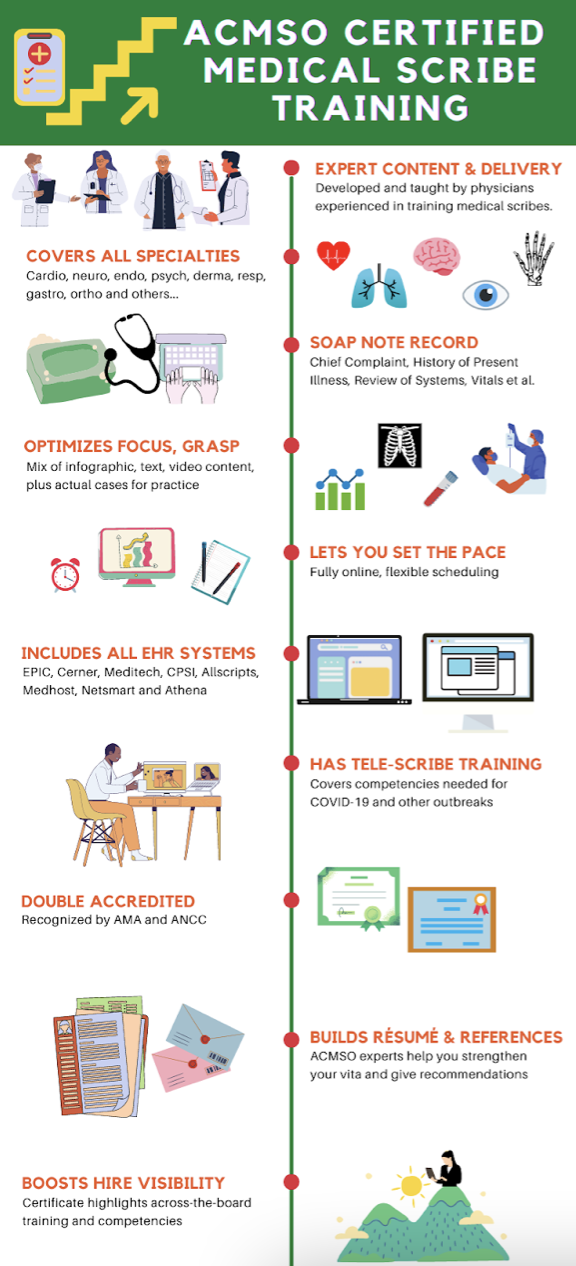
Medical scribing is a vital healthcare role. It supports physicians and improves patient care.
A medical scribing course trains individuals to become professional scribes. These scribes document patient interactions, manage electronic health records (EHR), and assist physicians with administrative tasks. The course covers medical terminology, anatomy, and EHR systems. It prepares students to work in various healthcare settings.
With healthcare becoming more complex, the demand for skilled medical scribes is growing. This course offers a pathway into the medical field without requiring extensive medical training. It’s an ideal option for those interested in healthcare but not ready for a full medical degree. Understanding what a medical scribing course entails can help you decide if this career is right for you.

Credit: acmso.org
Introduction To Medical Scribing
The field of healthcare is constantly evolving. One essential role that has gained prominence is medical scribing. This profession plays a vital part in ensuring accurate documentation and supporting healthcare providers. A medical scribing course offers the necessary training to excel in this role.
What Is Medical Scribing?
Medical scribing involves real-time documentation of patient-doctor interactions. A scribe records the patient’s history, treatment plans, and doctor’s notes. This ensures that the medical records are accurate and up-to-date. Scribes work alongside healthcare providers to improve efficiency and patient care.
Importance In Healthcare
Medical scribes help reduce the administrative burden on doctors. This allows doctors to focus more on patient care. Accurate documentation is crucial for patient safety and proper treatment. Scribes ensure that all details are recorded precisely, reducing errors in medical records.
By taking a medical scribing course, individuals gain the skills needed to perform this role effectively. They learn medical terminology, documentation techniques, and how to work in various healthcare settings. This training is essential for those looking to support the healthcare industry in a meaningful way.
Role Of A Medical Scribe
A Medical Scribing Course trains individuals to document patient visits in real-time. Medical scribes help doctors by managing records, allowing them to focus on patient care. This role requires attention to detail and strong communication skills.
A Medical Scribe works alongside doctors, capturing every detail during patient visits. They document patient history, exams, and treatment plans. This allows doctors to focus on patient care. Medical Scribes ensure accurate records and efficient workflow in healthcare settings.
Daily Responsibilities
Medical Scribes track patient interactions in real-time. They update electronic health records (EHR) with vital information. They assist with lab orders, imaging, and referrals. Scribes manage the documentation of patient visits. They ensure completeness and accuracy. This helps doctors save time and improve patient care.
Skills Required
Attention to detail is crucial for Medical Scribes. They must have strong listening skills. They need to understand medical terminology. Good typing speed is essential. Scribes should be proficient with EHR systems. Strong communication skills are also important. They need to work well under pressure. Adaptability and quick learning are key traits. Medical Scribes play a vital role in healthcare teams. “`
Benefits Of Becoming A Medical Scribe
Choosing a career as a medical scribe offers many benefits. It is a great way to enter the healthcare field. You gain valuable experience and skills. There are many rewards and opportunities available.
Career Opportunities
Medical scribes are in high demand. They work in various healthcare settings. Hospitals, clinics, and private practices all need scribes. This creates many job opportunities. Here are some key benefits:
- Job Security: Healthcare jobs are stable and growing.
- Flexible Schedules: Many positions offer part-time or shift work.
- Work Environment: Work in a professional and respectful setting.
Professional Growth
Becoming a medical scribe provides a strong foundation. It helps in advancing your career in healthcare. It offers many opportunities for learning and growth:
- Real-World Experience: Work directly with doctors and nurses.
- Skill Development: Improve medical terminology and documentation skills.
- Networking: Build connections with healthcare professionals.
Medical scribing is more than a job. It is a stepping stone to a rewarding career in healthcare. It offers valuable experiences and growth opportunities. Consider the many benefits of becoming a medical scribe.
Medical Scribing Course Overview
The Medical Scribing Course prepares students for a vital role in healthcare. Medical scribes assist doctors by managing patient records. This frees up doctors to focus more on patient care. The course combines theory and practical skills. It aims to produce competent medical scribes.
Course Content
The course covers medical terminology. Students learn anatomy and physiology. They study electronic health records (EHR) systems. The curriculum includes medical documentation. Students practice recording patient histories and exam results. The course also teaches legal and ethical issues in healthcare.
Duration And Structure
The Medical Scribing Course typically lasts six to nine months. It includes classroom instruction and hands-on training. Students attend lectures and participate in lab sessions. They complete assignments and exams. Practical training involves working in a clinical setting. This provides real-world experience.
Prerequisites For Enrolling
Understanding the prerequisites for enrolling in a Medical Scribing Course is crucial. This ensures that you are well-prepared and meet the basic requirements. Below, we outline the key prerequisites needed to join this course.
Educational Background
Having the right educational background is important for a Medical Scribing Course. Typically, you will need:
- A high school diploma or equivalent.
- Basic knowledge of biology and medical terminology.
Some courses might prefer candidates with a background in healthcare or life sciences. This helps in understanding medical terms and procedures more quickly.
Necessary Skills
Certain skills are essential for excelling in a Medical Scribing Course. These include:
| Skill | Description |
|---|---|
| Attention to Detail | Accurately recording patient information without errors. |
| Typing Proficiency | Typing quickly and accurately is crucial. |
| Communication Skills | Effectively interacting with healthcare professionals. |
| Time Management | Managing tasks efficiently within a given timeframe. |
Possessing these skills will make the learning process smoother and more effective. It will also help you perform better in a real-world medical scribing job.
Certification And Training
The Certification and Training in a Medical Scribing Course are crucial. They ensure that you are well-prepared for a career in medical scribing. This section will cover the essential aspects of certification and training.
Accreditation
Accreditation is a vital factor to consider when choosing a Medical Scribing Course. Accredited programs meet industry standards. They provide quality education and training. Look for programs accredited by recognized bodies. This ensures the course content is up-to-date and relevant.
Accredited courses are usually preferred by employers. They indicate that you have received proper training. This can give you an edge in the job market. Below is a table showing some well-known accrediting bodies:
| Accrediting Body | Region |
|---|---|
| American Association of Professional Coders (AAPC) | United States |
| Health Information Management Association (HIMA) | United Kingdom |
On-the-job Training
On-the-Job Training is a key part of the medical scribing course. It provides real-world experience in a healthcare setting. This training helps you apply what you have learned in class. You will work under the supervision of experienced medical scribes. This hands-on experience is invaluable.
The on-the-job training typically involves the following tasks:
- Documenting patient encounters
- Assisting doctors with medical records
- Learning to use Electronic Health Records (EHR) systems
This practical experience is essential. It prepares you for the actual work environment. It also helps you understand the workflow in a healthcare setting. Completing this training successfully can boost your confidence and competence. Employers value candidates with hands-on experience.
Career Pathways After Medical Scribing
Medical scribing is a growing field that offers various career pathways. After completing a medical scribing course, many opportunities await you. Here are some potential career paths you can explore.
Advancement Opportunities
Medical scribes can move up within the healthcare industry. With experience, you can become a senior scribe. Senior scribes often mentor new scribes and manage teams. You can also advance to scribe trainers. These professionals teach others the skills needed for medical scribing.
Transitioning To Other Roles
Medical scribes gain valuable experience that can lead to other roles. Many scribes become medical assistants. Medical assistants work directly with doctors and patients. Some scribes decide to pursue nursing. Nursing offers a hands-on approach to patient care.
Others may choose to become healthcare administrators. These roles involve managing healthcare facilities. Your scribing experience will be a great asset. You understand the workflow and the needs of medical staff.
Medical scribing can also be a stepping stone to medical school. Many scribes go on to become doctors. The experience helps them in their studies and future careers. It gives them a strong foundation in medical terminology and patient care.

Credit: www.linkedin.com
Tips For Success In Medical Scribing
Embarking on a medical scribing course can be a rewarding journey. To excel, you need to master a few key skills. Let’s explore some essential tips for success in this field.
Effective Communication
Effective communication is vital in medical scribing. You must relay information clearly between doctors and patients. This includes understanding medical terminology and conveying it accurately. Practice active listening. Repeat back what you hear to ensure understanding. This helps avoid errors and ensures clarity.
Attention To Detail
Attention to detail is crucial in medical scribing. Small mistakes can lead to significant issues. Always double-check your work. Ensure all patient information is accurate and complete. Develop a habit of reviewing notes before submitting them. A keen eye for detail can prevent many problems.
- Double-check patient names and details.
- Review medical histories thoroughly.
- Ensure all prescribed treatments are noted accurately.
Being detail-oriented ensures the safety and well-being of patients. It also enhances your credibility as a scribe.
| Skill | Importance |
|---|---|
| Effective Communication | High |
| Attention to Detail | High |
Mastering these skills will set you on the path to success in your medical scribing course. Focus on them, and you will excel.
Frequently Asked Questions
What Is A Medical Scribing Course?
A Medical Scribing Course trains individuals to assist physicians by documenting patient visits. It covers medical terminology, clinical procedures, and electronic health records.
Who Can Enroll In A Medical Scribing Course?
Anyone with a high school diploma or equivalent can enroll. It is ideal for those interested in healthcare careers.
How Long Does The Course Take?
Most Medical Scribing Courses take about 4 to 6 months to complete. The duration may vary depending on the institution.
What Skills Are Needed For Medical Scribing?
Key skills include attention to detail, strong communication, and familiarity with medical terminology. Proficiency in typing and electronic health records is also important.
Conclusion
A medical scribing course offers a solid career path. It builds skills for the healthcare field. You gain real-world experience while supporting doctors. This training opens doors to many opportunities. Plus, you can help improve patient care. A rewarding job awaits you in medical scribing.
Consider this course to start your journey today.





